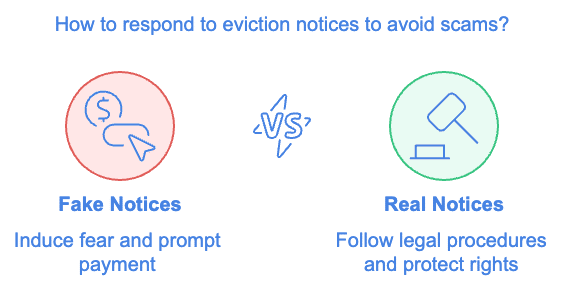
Moving for Section 8: How to Transfer Vouchers Safely
November 18, 2024
Hidden Fees in Affordable Housing: What’s Legitimate and What’s Not
November 18, 2024Receiving an eviction notice can be stressful, but it’s even worse if the notice turns out to be a fake. Scammers sometimes use false eviction notices to trick renters into paying fees or “back rent” that they don’t owe. In other cases, landlords may send unauthorized eviction notices to pressure tenants without following legal procedures. At Section 8 Shield, we’ve seen how fake eviction notices target renters and have developed this guide to help you identify them, avoid scams, and understand your rights.
Why Scammers Use Fake Eviction Notices
Fake eviction notices exploit a renter’s fear of losing their home, especially if they’re unfamiliar with local eviction laws or unaware of their rights. These scams typically have one goal: to get tenants to pay money under false pretenses. In some cases, dishonest landlords might send unofficial notices to intimidate tenants into moving out or to pay disputed fees.

Being able to recognize the signs of a fake eviction notice is key to avoiding unnecessary payments and stress.
Common Signs of a Fake Eviction Notice
Here are the most common indicators that an eviction notice may be fake:
1. Lack of Court Information or Official Stamp
- What to Look For: In most jurisdictions, eviction notices that progress to court will have official documentation with court information and, often, a court stamp. A notice without any court details or that doesn’t look official is a red flag.
- How to Verify: Check your local laws to see what a legitimate eviction notice should include. Often, only a judge or court can issue a final eviction order.
2. No Landlord or Property Manager Contact Information
- What to Look For: Legitimate eviction notices typically include the landlord or property manager’s full contact information. Fake notices often have limited or incorrect contact details.
- How to Verify: Confirm that the contact information matches previous communications from your landlord. If in doubt, contact your landlord directly using contact information you already have to confirm the notice.
3. Demands for Immediate Payment via Unusual Methods
- What to Look For: Scammers often demand immediate payment through untraceable methods like cash, gift cards, or payment apps (e.g., Venmo, Zelle, Cash App).
- How to Verify: Check your lease agreement and state regulations on rent collection. Landlords typically have specific payment methods in place, and sudden changes or demands for payment through unfamiliar channels are suspicious.
4. Spelling and Grammar Errors
- What to Look For: Fake notices often contain poor grammar, spelling mistakes, or incorrect legal terms. Official documents from legitimate landlords or courts are generally free from such errors.
- How to Verify: Review the notice for professionalism. If it looks hastily written or contains multiple errors, it may not be legitimate.
5. Pressure Tactics and Threatening Language
- What to Look For: Scammers often use strong, intimidating language, such as threatening immediate eviction or legal action within 24 hours if you don’t comply. Real eviction notices typically follow a structured, legal format and don’t use extreme scare tactics.
- How to Verify: Eviction processes are generally not immediate and must follow specific steps. If the notice demands “immediate” action, consult local housing laws to confirm the legitimate eviction timeline.
6. No Detailed Reason for Eviction
- What to Look For: Legitimate eviction notices must clearly state the reason for eviction, such as unpaid rent, lease violations, or non-renewal of the lease. Fake notices may simply say, “You must vacate” without giving a valid reason.
- How to Verify: Cross-reference the reason with your lease terms. If there’s no clear cause or the reasoning doesn’t match your situation, the notice may not be legitimate.
7. Notice Not Delivered in Person or via Certified Mail
- What to Look For: Most eviction notices are delivered in person, posted on the door, or sent via certified mail to ensure receipt. Emails, text messages, or regular mail notices are often not legally binding.
- How to Verify: If you receive an eviction notice through unconventional means, verify with your landlord or contact a housing authority to confirm its validity.
How to Verify an Eviction Notice’s Authenticity
If you suspect an eviction notice might be fake, here are steps you can take to confirm its legitimacy:
| Contact Your Landlord Directly | Why It’s Important: Sometimes miscommunication or clerical errors can lead to confusion. Contact your landlord using verified contact information to confirm whether they sent the notice. What to Do: Ask your landlord about the notice’s contents, reasons for eviction, and next steps. A legitimate landlord should be able to provide clarification and documentation. |
| Consult Your Local Housing Authority or Tenant Union | Why It’s Important: Local housing authorities and tenant unions are knowledgeable about eviction laws and can help verify if the notice is legitimate. What to Do: Bring a copy of the notice to your local housing authority or tenant union. They can provide guidance on whether the notice meets local legal standards and advise on next steps. |
| Research Local Eviction Laws | Why It’s Important: Understanding your state or city’s eviction process can help you recognize if the notice follows legal procedures. What to Do: Research eviction laws specific to your area. Many states require specific timelines, documentation, and reasons for eviction. Compare these requirements to the notice you received. |
| Check Court Records if You’ve Been Summoned | Why It’s Important: If the notice includes a court date, you can confirm this by checking with your local courthouse. What to Do: Call or visit your local court to verify if an eviction case has been filed in your name. Many courts also have online portals where you can check your case status. |
| Seek Legal Advice | Why It’s Important: Tenant attorneys or legal aid organizations can help you determine if an eviction notice is legitimate and advise on how to respond. What to Do: Contact a tenant lawyer or legal aid organization in your area. They can review the notice and inform you of your rights, especially if you believe the notice is fake. |
Steps to Take If You’ve Received a Fake Eviction Notice
If you’ve confirmed that an eviction notice is fake, here’s what you can do to protect yourself:
1. Report the Fake Notice to Section 8 Shield
- Why It’s Important: Reporting the scam can help alert other renters to potential fraud.
- How to Do It: Visit Section 8 Shield’s scam alert page and provide details about the fake eviction notice, including the sender’s contact information and any suspicious language used.
2. File a Police Report
- Why It’s Important: Filing a police report creates a formal record of the scam, which can support any financial disputes or legal action.
- How to Do It: Bring a copy of the notice, proof of your rent payments, and any documentation related to the notice to your local police department.
3. Notify Local Housing Authorities
- Why It’s Important: Your local housing authority may be able to provide additional resources and may already be tracking similar scams.
- How to Do It: Contact your city’s housing authority and explain the situation. They may investigate the notice, especially if they’ve received reports of similar scams in the area.
4. Warn Other Tenants if the Scam Targets Multiple Units
- Why It’s Important: If the scam appears to target multiple units or tenants, sharing your experience can prevent others from falling victim.
- How to Do It: Speak with your neighbors or tenant association about the notice. Scammers often send fake eviction notices to multiple tenants in the hope that at least one will pay.
Tips for Avoiding Eviction Scams in the Future
Taking proactive steps can help you avoid falling victim to fake eviction notices and similar scams. Here are some key tips:
1. Always Verify Communication from Landlords or Property Managers
- Communicate directly with your landlord or property management company using contact information from your lease. If you receive any unexpected notices, confirm their legitimacy through official channels.
2. Stay Informed About Local Eviction Laws
- Understanding your state or city’s eviction process and tenant rights helps you recognize when a notice doesn’t follow proper procedures. Familiarize yourself with local requirements for eviction timelines, documentation, and delivery methods.
3. Keep Records of Rent Payments and Lease Documents
- Having proof of your rent payments and lease agreement helps defend against any false claims or fake eviction notices. Maintain receipts, bank statements, or other documentation showing your payment history.
4. Report Suspicious Activity
- If you suspect fraud, report it to your local housing authority, Section 8 Shield, or other tenant organizations. Scammers often rely on renters’ hesitation to report, so taking action can help prevent future scams.
Protecting Yourself from Fake Eviction Notices
Fake eviction notices are a scare tactic used by scammers and dishonest landlords to manipulate tenants into paying money or moving out. By understanding the common signs of a fake notice and knowing your rights, you can protect yourself and avoid unnecessary stress. Section 8 Shield is here to support you with resources, information, and a platform for reporting scams.
If you receive an eviction notice, don’t panic—verify its authenticity, understand your rights, and take the necessary steps to respond safely. With the right precautions, you can protect yourself and your home from scams.




